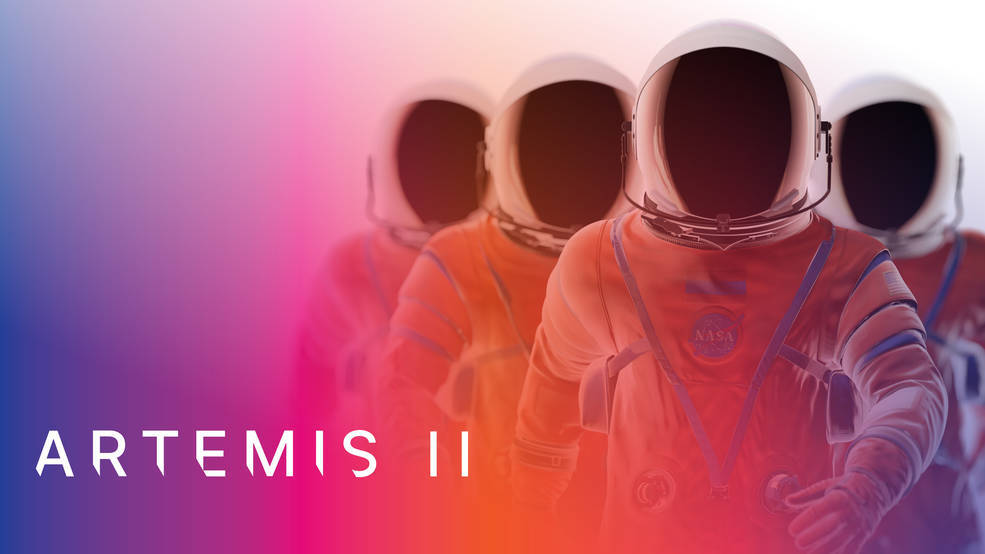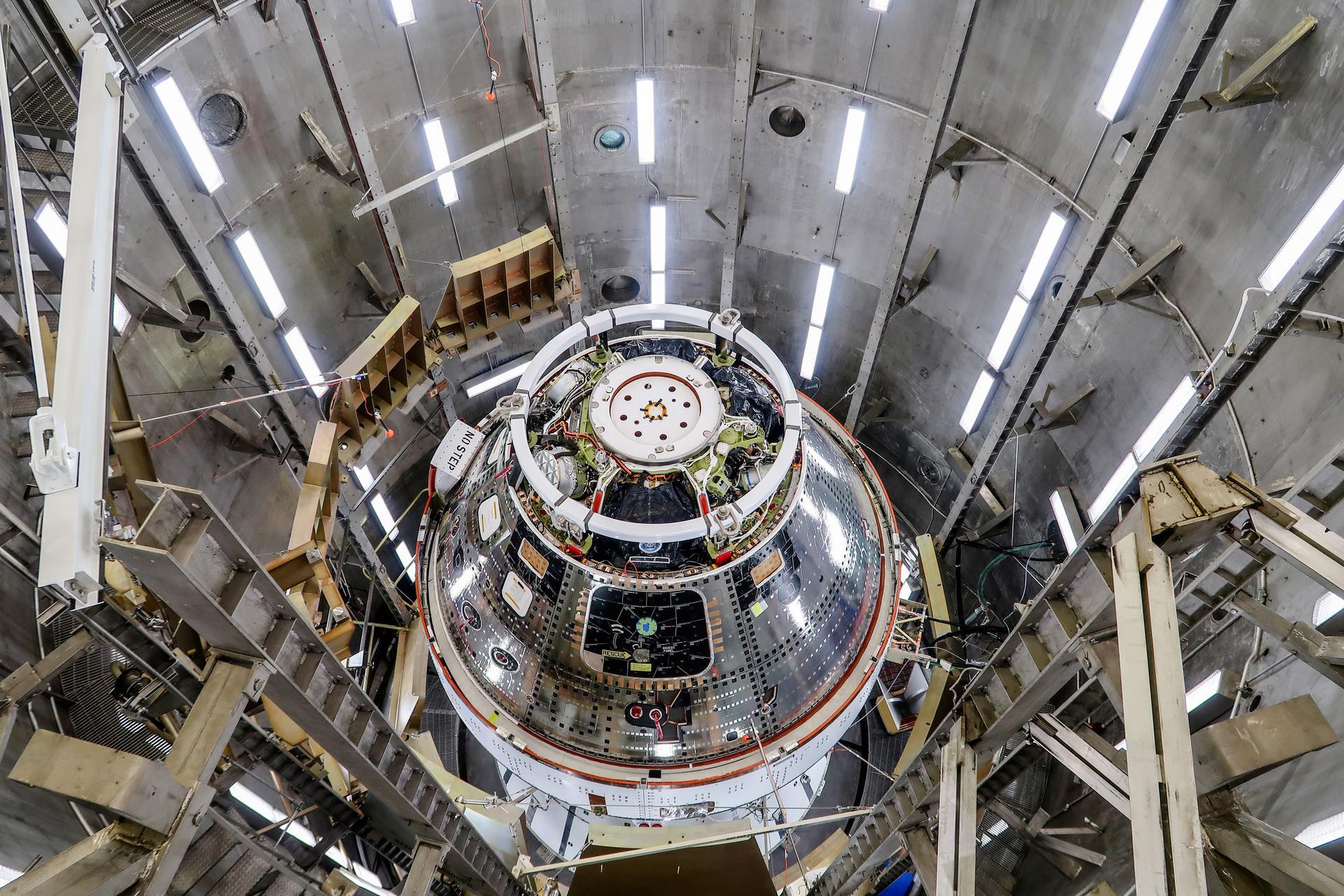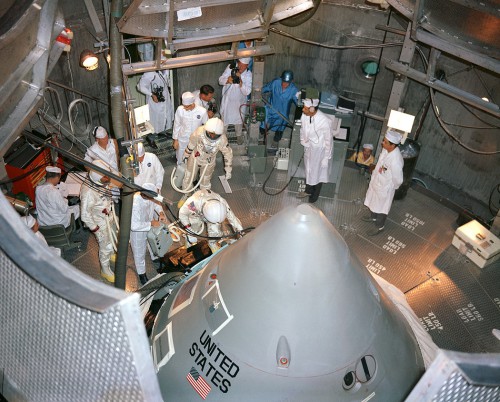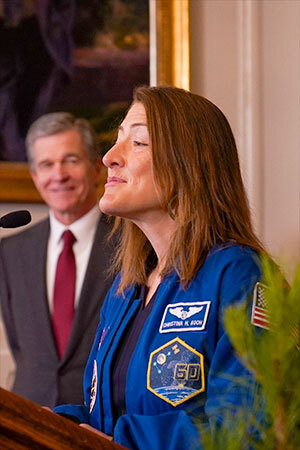16.04.2024

Orion Spacecraft Enters Rarefied Air with Vacuum Test

Artemis 2’s Orion crew and service modules await testing inside the refurbished Apollo vacuum chamber. Credit: NASA/David Wellendorf.
After nearly six years of work, the first human-rated Orion spacecraft is complete. The capsule will carry astronauts Reid Wiseman, Victor Glover, Christina Koch, and Jeremy Hansen to the Moon during next September’s Artemis 2 mission. Orion undoubtedly looks like a fully-functional spacecraft. The crew and service modules were mated last November, and the former is now shrouded in its reflective thermal protection system tiles. Inside the crew cabin, the control panels have been installed for an in-flight manual piloting test. With all this being said, the Artemis 2 spacecraft is still factory-fresh and must prove that it is ready to face the hostile environment of space. On April 4th, NASA transported Orion to a vacuum chamber to begin a fundamental sequence of preflight tests.

Artemis 2’s Orion capsule still lacks an official name. However, mission commander Reid Wiseman told AmericaSpace that the engineers at the Kennedy Space Center (KSC) have taken to calling it “The Ship.” “The young men and women working on this vehicle have a complete and personal attachment to ‘The Ship,’” said Wiseman. “They spoke of it so endearingly.”
Some of the engineers have been working on this magnificent spacecraft ever since it arrived at the Kennedy Space Center in October of 2018. At that point, the infant Orion was nothing more than an olive-green pressure vessel milled out of panels of aluminum-lithium alloy. It was no more a spacecraft than the framework of a chassis is a car. During the intervening six years, the KSC team outfitted it with propellant tanks and thrusters, a life support system, a heat shield, crew cabin furnishing, and 15 miles of wiring. They are undoubtedly proud to see the completed “Ship” preparing to spread its solar array wings.
Artemis 1’s Orion spacecraft was completed in November of 2019, but it had to wait three years to fly due to unforeseen development challenges with its SLS launch vehicle. For Artemis 2, the situation is inverted. The elements of the SLS are ready for stacking, while Orion is the pacing item for the schedule. NASA is working to resolve four issues which appeared during final preparations for the mission. AmericaSpace’s Ben Evans described the first three anomalies in detail in his January feature on Artemis; the final issue surfaced one month later. The Orion program’s approach to resolving these safety-critical issues is described below.
1) Heat shield: During reentry, Orion is protected an ablative material called Avcoat. As it is heated, an ablative heat shield slowly chars, liberating microscopic flakes and gases; these products then carry thermal energy away from the spacecraft. Following the splashdown of Artemis 1, the recovery team documented that several larger chunks of Avcoat were also lost. While a healthy amount of material was left behind, NASA would like to understand this unexpected behavior before entrusting the heat shield with the lives of Wiseman, Glover, Koch, and Hansen.
The root cause of the anomaly is still under investigation. However, Amit Kshatriya, the associate administrator who leads NASA’s Moon to Mars program, noted that it could be a byproduct of Orion’s novel skip entry [1]. “We went frame by frame through every piece of video we had from Orion to determine when the initiation of that char liberation began, and most of it was after we stated climbing out of that first dive into the skip,” he said. If the excess ablation is, indeed, the result of the skip entry, NASA could elect to replace it with a direct trajectory; the tradeoff would be that Orion would endure higher peak heating and splash down further from shore.
2) ECLSS valves: The Orion Environmental Control and Life Support System (ECLSS) will make its debut on Artemis 2. The lunar flyby captures the lion’s share of publicity, but testing the ECLSS is considered the most important objective of the mission. Until late last year, Artemis 2’s completed life support system appeared to be flawless. However, its reliability was called into question when a controller for Artemis 3’s ventilation system failed during a preflight test.
The failure was traced back to a circuit within the motor which activates one of the valves adjusting the flow of gases through the crew cabin. Identical valves are spaced throughout the ECLSS, and every one of them had to be hardened to withstand excess voltage. In a subsequent interview with NASASpaceflight’s Phillip Sloss, Kshatriya revealed that the concerning issues with the ECLSS should soon be a thing of the past [2]. “They finished all that work (modifications) in the last three months, did the re-acceptance testing, shook it, did all the thermal sweeps, screened it for workmanship, and it’s over there at KSC.”
3) Battery disconnection: During launch, Orion is entirely dependent upon its batteries for power. A vibration test revealed that the batteries might become disconnected from the rest of the capsule’s systems during a worst-case abort scenario. Such a failure would render the spacecraft unable to deploy its parachutes and splash down safely. This is a fringe scenario, as it would require both a failure of the SLS and the most extreme vibrational environment possible as the abort motor fired. However, given the catastrophic consequences of a battery failure and unanticipated margin in the Artemis 2 schedule due to other anomalies, NASA elected to fix it anyway.
The resolution of the battery issue is lagging behind the work on the ECLSS system. In his interview with NASASpaceflight, Kshatriya said, “I think we have a good understanding of the environment (…), and so there are a couple of things that they’re working through in terms of either a repair of the existing batteries or an acceleration off the Artemis 3 shipment.” He added, “We have to settle on what the battery solution is going to be, so there is a fair bit of uncertainty there. I think we’ve accounted for it in the risk for the overall schedule.”
4: Side hatch: In a distant echo of the lessons learned from the Apollo 1 tragedy, there are also concerns about Orion’s side hatch. In the event of an emergency on the launch pad, such as a fire or a toxic gas leak, Wiseman, Glover, Koch, and Hansen must be able to evacuate Orion in a matter of seconds. In February, the Aerospace Safety Advisory Panel (ASAP)’s William Bray disclosed, “NASA has been investigating a number of issues associated with the side hatch design. It’s really specifically in an area where it could affect (the crew’s) ability to open the hatch in a contingency operation” [3]. He did not disclose the details of the anomaly, but ASAP later wrote that it can occur when there is a pressure differential between the crew cabin and the surrounding atmosphere. ASAP was concerned that, in some scenarios, the mechanisms which open the hatch might not be able to overcome a difference in pressure between the two environments.
NASA’s Public Affairs Office generously provided an update on the investigation in response to an inquiry from AmericaSpace: “NASA continues to work the design of Orion’s side hatch regarding operations under pressure changes across the hatch in normal and emergency scenarios. NASA previously noted that data on the hatch’s hinges required additional analysis and testing to ensure the hatch can safely open in all cases either by recovery personnel or by the crew themselves, if necessary. Full scale testing is underway to verify the capability and develop operations required to ensure the hatch can be opened in a variety of different potential pressure scenarios. This is not expected to drive the critical path for Artemis II.”
All four issues are still in various stages of investigation and/or repair. However, NASA is reasonably confident that it will be able to resolve all of them in time to meet Artemis 2’s current targeted launch date. “I would say there’s nothing I’ve seen in the recovery plans or the test plans that would give me any pause that we’re not going to be able to hold the date that we pushed out in January, with some margin,” Kshatriya told Sloss.
With that expectation in mind, NASA is pushing ahead with Orion’s most significant integrated test. Thermal and vacuum (TVAC) testing verifies that a space vehicle is able to withstand the negligible pressures and extreme temperatures found in space. It is standard protocol for all piloted and robotic spacecraft, including Artemis 2.
The Artemis 1 Orion served as a pathfinder for its sister ships. Prior to its lunar mission, the capsule and its service module were flown to NASA’s Glenn Research Center aboard a Super Guppy aircraft. There, they were placed inside the world’s largest vacuum chamber at the Plum Brook Facility for a comprehensive series of tests. The Plum Brook vacuum chamber is able to reproduce the pressures and temperatures found in space simultaneously. The drawback? It would be infeasible to shuttle Orion vehicles between Florida and Ohio while maintaining an annual cadence of Artemis missions.
To support Artemis 2 and future missions, NASA refurbished one of the two venerable vacuum chambers which were used to test the Apollo spacecraft. The Orion final assembly line is at one end of the Operations and Checkout Building, and it has been teeming with activity for over a decade. The derelict vacuum chambers were at the other end of the building. Each chamber is a 33-foot-wide, 44-foot-tall cylinder. They can replicate the negligible pressure found at 250,000 feet (47 miles), which is over six times higher than the cruising altitude of an airliner and just three miles beneath the U.S. demarcation line for the edge of space. Thermal testing is performed in separate facilities. For the Artemis program, NASA chose to upgrade the left (west) facility since it was closer to the Orion production area.
The Kennedy Space Center’s vacuum chambers have a storied history. They were built in 1965 so that NASA could test the Apollo spacecraft in the same facility which prepared them for flight. They were used to test every Command and Service Module and every Lunar Module, from the ill-fated Apollo 1 capsule to Apollo 17’s America. Whenever a CSM was placed inside the chamber, the prime crew would board it and test procedures while the vacuum test was underway. As they could not take advantage of microgravity to move around the confined spacecraft in three dimensions, this was undoubtedly an uncomfortable experience.
The vacuum chambers were used to test the Apollo-Soyuz Test Project’s docking module. Once that mission lifted off, they were largely abandoned. However, the chambers were occasionally used to test the Spacelab modules which flew in the Space Shuttle’s payload bay, as well as the laboratories, habitats, and nodes of the International Space Station.
Given its age, a team of 70 engineers needed to upgrade the vacuum chamber in order to prepare it for the next chapter in its career. Upgrades included new vacuum pumps, improved lighting, and a new control room with up-to-date electronics. Once they finished the renovation, the Orion team carefully lifted the completed Artemis 2 spacecraft into the chamber on April 4th.
Next, Orion will be put through a series of tests which will replicate the environment found in cislunar space. Electromagnetic Compatibility (EMC) and Electromagnetic Interference (EMI) testing are already underway. These two tests sound similar, but they fulfill distinct purposes. The former confirms that the spacecraft will not be inhibited by radio wave emissions from external sources, such as the Sun, the Earth, and the galactic background. The latter verifies that the spacecraft itself does not release electromagnetic radiation which could disrupt its mission or damage its own components. In a statement to AmericaSpace on April 10th, NASA’s Public Affairs Office said that EMC and EMI testing should last through the end of the month.
Following the completion of these first two tests, Orion will be temporarily moved back to the production line for unspecified “further work” [4]. This might include repairing or replacing the spacecraft’s batteries if the disconnection anomaly is resolved. If the batteries are still not ready for installation, Kshatriya noted that they can be installed at a later date after the spacecraft is moved back into the vacuum chamber [2].
The Public Affairs Office informed AmericaSpace that the vacuum test itself is scheduled for July. This will be the pinnacle of the Artemis 2 test series. Even though the generic Orion design is space-rated, there are several worthwhile reasons to place each new vehicle in a vacuum while it is still on Earth. The test will confirm that there are no leaks in the pressure vessel. It will also allow any volatile compounds on the spacecraft to exsolve, preventing them from influencing Orion’s performance once it is in space. After the test is complete, Orion will be handed over to the launch processing team to be stacked with its SLS rocket.
Quelle: AS
----
Update: 27.04.2024
.
NASA begins delivering Artemis Moon Trees to be planted across US

Artemis II astronaut Christina Koch is seen the Governor's Mansion in her home state of North Carolina as Governor Roy Cooper looks on, on Wednesday, April 24, 2024. (NC Governor's Office)
The first woman slated to launch to the moon has delivered one of the first trees grown from seeds recently flown there.
NASA astronaut Christina Koch presented a Loblolly Pine "Moon Tree" sapling to her home state of North Carolina on Wednesday (April 24). The tree began as one of more than 1,000 seeds that were flown around the moon on NASA's uncrewed Artemis I mission in 2022.
"With the planting of an Artemis Moon Tree today at the governor's mansion, North Carolina is firmly planting the roots of exploration for generations to come," said Koch, who is targeted to launch in late 2025 as a member of the Artemis II crew.
Koch's presentation marked one of the first deliveries to a new generation of Moon Tree stewards, who NASA has selected from across the country. Koch's alma mater, White Oak High School in Jacksonville, North Carolina, is another of the chosen recipients.
"I used to dream about going to space by looking up through the pine trees, and so, it was just a really great symbol of our commitment to North Carolina, North Carolina's commitment back to NASA, and all the amazing universities here that produce people for the aerospace industry," said Koch according to The Daily News, the local newspaper in Jacksonville. "That whole Artemis generation that's coming up here and that we can't wait to see exploring space."
In addition to the loblolly pines, which are native to North Carolina, the Orion spacecraft that flew on Artemis I also carried sycamore, sweetgum, Douglas-fir and giant sequoia seeds on its 270,000-mile (435,000-kilometer), 25-day journey. Back on Earth, the U.S. Department of Agriculture's Forest Service oversaw that the seeds germinated and grew into seedlings for their distribution as Artemis Moon Trees.
In August 2023, NASA put out a call for interested educational and community organizations to apply to grow a Moon Tree. The space agency chose recipients based on their ability to care for the various tree species and their position to use the tree's growth as an outreach tool in their neighborhoods, cities or states.
"Together, NASA and the Forest Service will deliver a piece of science history to communities across our nation," said Mike Kincaid, associate administrator of NASA's Office of STEM (science, engineering technology and math) engagement. "Through this partnership, future explorers, scientists and environmentalists will have the opportunity to nurture and be inspired by these Artemis artifacts in the community where they live, work and learn."
NASA is notifying the selected institutions in waves, with the first now underway, followed by groups in the fall of this year, spring 2025 and fall 2025. The agency plans to keep a record of the recipients on its website, noting the species of tree they received and their planting cycle.
Moon Tree hosts will also be invited to engage with the public at quarterly virtual gatherings beginning this summer.
A full list of the first, almost 50 recipients has yet to be made public, but according to a social media post, Mary Chapa Academy in Greenfield, California received a sapling on Thursday (April 25).
The idea for the Artemis I Moon Trees was grown out of a similar project carried out by Apollo 14 command module pilot Stuart Roosa, who as a former Forest Service smoke jumper launched with hundreds of tree seeds in his personal preference kit on the 1971 moon mission. The Apollo Moon Tree seedlings were planted across the U.S., with many becoming part of the country's bicentennial celebration in 1976.
"A new era of Moon trees will one day stand tall in communities across America," said Bill Nelson, NASA's Administrator. "NASA is bringing the spirit of exploration back down to Earth because space belongs to everyone. The Artemis Generation will carry forth these seedlings that will be fertile ground for creativity, inspiration, and discovery for years to come."
Quelle: CS

